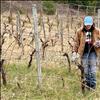Climate Corner
Climate change and crop production in Montana
Hey savvy news reader! Thanks for choosing local.
You are now reading
1 of 3 free articles.
Montana’s agriculture sector has always been vulnerable to changes in climate, and generations of farmers and ranchers have proven their ability to adjust and prosper as conditions demand.
Current climate changes driven by rising greenhouse gas emissions, chiefly produced by burning fossil fuels, impact working lands. While rising temperatures and increasing spring and fall precipitation have benefitted some crop production, these climate trends pose challenges.
More days over 90oF have resulted in serious reductions in crop yields of Montana’s most important commodity crops. The flash drought of 2017–when a wet spring suddenly turned to extremely hot dry weather in June–was devastating for dryland wheat and barley grain yields.
These events are likely to become more frequent with changing precipitation patterns. Montana experienced 13 drought periods and climate-driven weather events costing over $1 billion in damages between 1980 and 2024 (National Oceanic and Atmospheric Administration).
Notwithstanding extreme events, rising winter low temperatures may partly explain the increase in weeds, like cheatgrass, ryegrass, and jointed goatgrass, that impact wheat production.
Montana’s frost-free period has lengthened by 5 days per decade since 1980 and is projected to be a month longer by 2085. Longer growing seasons suggest the possibility of turning to higher value crops, like corn and soybeans, but they require a lot of water and more fertilizer and pesticide inputs. Corn and soybeans are largely used to feed confined livestock and to produce ethanol for cars, contributing to greenhouse gas emissions.
Eastern Montana’s sugar beet crop is particularly vulnerable to growing-season shortages of irrigation water and untimely snow during harvest. In 2019, sugar beets were harvested in a snowstorm presenting challenges for processors and farmers because of reduced beet-storage longevity. Flathead cherry harvests in 1989, 1991, and 2024 were severely reduced by early onset of freezing temperatures.
Planning for future drought rather than short-term gain can avoid unwise investments in thirsty crops, irrigation infrastructure, fertilizers, pesticides, and other inputs.
Several actions can increase climate-change resilience. Rather than leave fields fallow, planting cover and other rotational crops increases soil organic matter and water storage that, in turn, help commodity crops endure drought conditions. Planting drought-tolerant and fall-season crops takes advantage of new precipitation patterns, reduced groundwater supplies, and less water for irrigation. Crops that tolerate climate-driven weather events can reduce short-term economic losses. Woody plants that store carbon in roots and stems could be integrated into agricultural practices by planting windbreaks and tree crops.
What role will Montana agriculture play in mitigating greenhouse gas emissions? Will we grow crops that maximize carbon fixation, reduce water use, and increase soil carbon? Will we continue to supply global food needs in a rapidly changing future with multiple uncertainties?
Agricultural practice decisions are influenced by a range of historical factors including economics, past crop performance, equipment constraints, and local and global markets. Climate change will play an increasing role in selecting cropping practices. Success will depend on: (1) our ability to change crops to more drought-tolerant varieties and species; (2) increased farmer flexibility; (3) incentive programs that adopt carbon-storing practices; (4) marketing the nutritional value of current and new crops to produce more food per unit area; and, (5) decreased reliance on expensive fertilizers and pesticides.
Montana family farms and ranches operate near the economic margin as it is, so increasing costs to maintain current production with inputs and a reliance on insurance are not long-term solutions.
Farmers and ranchers will face difficult decisions in the coming decades. Adaptability and mitigation planning in the agriculture sector depend on having timely information that will guide long-term climate-related solutions.
Bruce Maxwell is Professor Emeritus in the Department of Land Resources & Environmental Sciences at Montana State University.















